Audubon's America
By Phillip Caprara • May 19, 2022
When John James Audubon completed his monumental work, The Birds of America, in 1838 every species he had depicted was still thought to be extant. In this regard, The Birds of America is critical for displaying the ornithological biodiversity during Audubon's time. Yet during his research ventures, Audubon noticed that some species were, or had become, uncommon over a relatively short period. In 1844, the same year the fourth and final volume of the Royal Octavo edition was completed, one species, the Great Auk, was to be, quite literally, throttled and smashed into extinction. Within a century of initial publication, four more species illustrated by Audubon would go extinct. In honor of Endangered Species Day, let's take a look at some of the birds of Audubon's America, both those no longer with us, and those saved by the hard work of dedicated conservationists around the world.
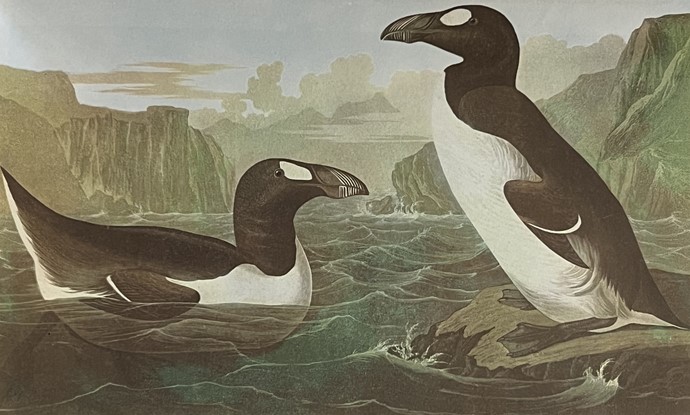 Our story begins with the Great Auk. Once prominent across the Middle and North Atlantic, the Great Auk was hunted for fishing bait as well as for its extremely soft down. Their popularity had resulted in dangerous populations declines noted well before Audubon's day, resulting in a hunting ban in Britain in 1794. Audubon himself never saw one and could not get any recent accounts when searching. In 1844 three Icelanders came to Eldey, which had become the last known breeding ground, and throttled the final two wild Auks. All their remaining eggs were smashed.1
Our story begins with the Great Auk. Once prominent across the Middle and North Atlantic, the Great Auk was hunted for fishing bait as well as for its extremely soft down. Their popularity had resulted in dangerous populations declines noted well before Audubon's day, resulting in a hunting ban in Britain in 1794. Audubon himself never saw one and could not get any recent accounts when searching. In 1844 three Icelanders came to Eldey, which had become the last known breeding ground, and throttled the final two wild Auks. All their remaining eggs were smashed.1
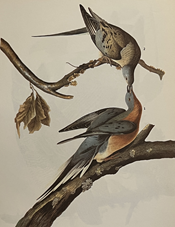
No extinction would have shocked a nineteenth century American so thoroughly as that of the Passenger Pigeon. Accounts speak of them blackening the sky in their magnificent flocks. It was so prevalent that Audubon recounted seeing one hundred sixty-three distinct flocks in a single day. They were known to be highly social, congregating in staggeringly large flocks, thousands strong. Yet it was this highly social behavior that would be their downfall. Sport hunters would use wounded pigeons to lure flocks into nets for later wholesale slaughter. Like others of his day, Audubon thought the pigeon undiminished by hunting efforts. Yet by 1914 the last captive female, Martha, died in the Cincinnati Zoo.
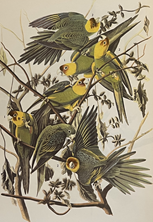 It might surprise you to learn that the Southeastern United States was once home to a vibrantly colored species of Parrot, the Carolina Parakeet. Colonial accounts are replete with mentions of these exotic looking birds, whose loud calls and large flocks made them a noticeable part of the Southeastern American forests. With beautiful green, yellow, and red feathers, it was highly sought after for the hat and pet trades and, because flocks could cause large scale damage to agricultural products, was hunted as a pest. Like the Passenger Pigeon, its highly social flocking behavior drove it to swarm and land near wounded or dead members, resulting in massive slaughters. Partially because it was also seen as a nuisance to crops, little was done to try to protect the Carolina Parakeet and, in 1939, the last captive specimen, Incas, died.
It might surprise you to learn that the Southeastern United States was once home to a vibrantly colored species of Parrot, the Carolina Parakeet. Colonial accounts are replete with mentions of these exotic looking birds, whose loud calls and large flocks made them a noticeable part of the Southeastern American forests. With beautiful green, yellow, and red feathers, it was highly sought after for the hat and pet trades and, because flocks could cause large scale damage to agricultural products, was hunted as a pest. Like the Passenger Pigeon, its highly social flocking behavior drove it to swarm and land near wounded or dead members, resulting in massive slaughters. Partially because it was also seen as a nuisance to crops, little was done to try to protect the Carolina Parakeet and, in 1939, the last captive specimen, Incas, died.
It isn't all bad news, though. While the stories of the Great Auk, Passenger Pigeon, and Carolina Parakeet ended through human interference, two other large birds, the Whooping Crane and California Condor, have been brought back from the brink of extinction through direct conservation efforts.
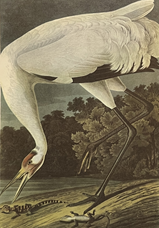 Already in decline during Audubon's time, the Whooping Crane (Hooping Crane as he called it) was hunted extensively for its beautiful feathers for dresses, hats, and even fans. By 1941, a little over a century after Birds of America's original publication, there were only fifteen wild individuals left.2 Through the captive-breeding programs of George W. Archibald in the 1970's, and several major reintroduction attempts, the whooping crane population began to gradually improve. Progress has been slow, but by 2017 the Aransas-Wood Buffalo population, the only remaining wild migratory population, was over 505 individuals.3
Already in decline during Audubon's time, the Whooping Crane (Hooping Crane as he called it) was hunted extensively for its beautiful feathers for dresses, hats, and even fans. By 1941, a little over a century after Birds of America's original publication, there were only fifteen wild individuals left.2 Through the captive-breeding programs of George W. Archibald in the 1970's, and several major reintroduction attempts, the whooping crane population began to gradually improve. Progress has been slow, but by 2017 the Aransas-Wood Buffalo population, the only remaining wild migratory population, was over 505 individuals.3
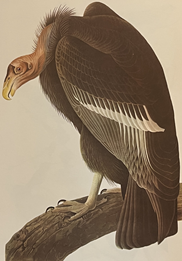
Perhaps the greatest success story, is that of the California Condor, the largest wild bird in North America. This titan of the skies became extinct in the wild in 1987 when Jan Hamber successfully captured the last remaining wild individual as part of a desperate conservation effort.4 Only twenty-three individuals remained alive, anywhere in the world.5 Thanks to the tireless efforts of conservationists like Hamber, two University breeding programs were able to establish a stable breeding population. Just five years after the capture of the last wild bird, California Condors were reintroduced in 1992 at Big Sur, Pinnacles National Park and later at Bitter Creek National Wildlife Refuge. By 2004 there were estimated to be approximately two-hundred and thirty wild condors.6 Two were even reintroduced in 2022!7 The most recent population estimates suggest over 500 California Condors are alive today, over 300 of which are in the wild.8
More than 1,300 species of plants and animals in the United States are considered Endangered or Threatened today, a number Audubon would have found staggering. While some of the sights of Audubon's America are lost to us forever—the sky-blackening flocks of Passenger Pigeons and the majestic calls of the Carolina Parakeet—others are more within reach than ever; a visitor to the American Southwest today can set his or her hopes on viewing America's largest bird in the wild, unthinkable thirty years ago, and do exactly that. Similarly, a wintertime visitor to Aransas National Wildlife Refuge in Texas can see a Whooping Crane more easily than Audubon ever could have. These successes in conservation, and others like them in the fields of botany, mammalogy, marine biology, and many others, are the key to maintaining the tremendous biodiversity that Audubon celebrated in his visions of America.
1 Fuller, Errol. 1999. The Great Auk. Southborough. p.82-83.
2https://www.nacwg.org/wcra%202019feb.pdf p.2.
3Ibid. p.2.
4Nielsen, John. 2006. Condor: To the Brink and Back—The Life and Times of One Giant Bird. New York. p.24.
5https://www.fws.gov/species/california-condor-gymnogyps-californianus
6Ibid.
7https://www.npr.org/2022/05/03/1096447625/condors-return-california-redwoods
8https://ielc.libguides.com/sdzg/factsheets/californiacondor/population



